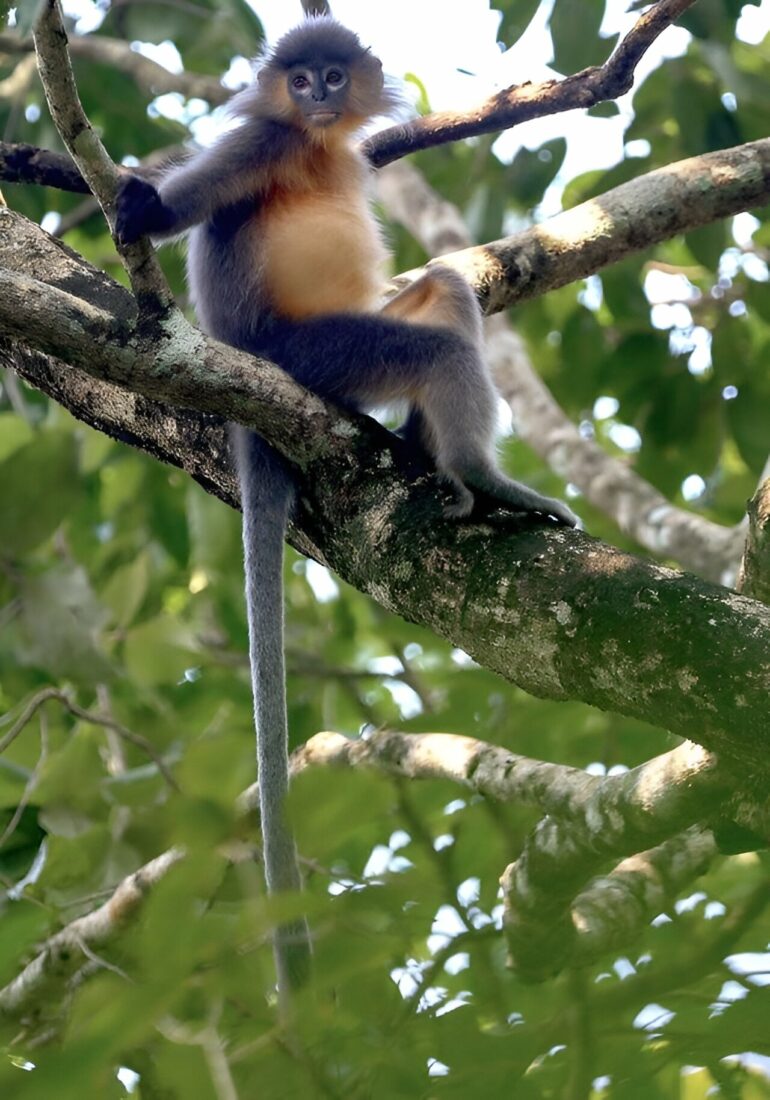Research shows a threatening development for two endangered primate species in Bangladesh: Phayre’s langurs (Trachypithecus phayrei) and capped langurs (Trachypithecus pileatus). In mixed groups of these two species, hybrids have been found and genetically confirmed. If hybridization continues, it could mean the extinction of one or both species.
The paper is published in the International Journal of Primatology.
Over five years (2018–2023), an international team of researchers led by Tanvir Ahmed, a Ph.D. student at the German Primate Center, studied the langur populations in north-eastern Bangladesh. They found that 8 of the 98 langur studied groups consisted of Phayre’s and capped langurs, and in three groups, some individuals appeared as a mixture of the two species.
Later, researchers analyzed genetic samples of the species in the lab of the German Primate Center, and confirmed one case of hybridization. This langur had a capped langur mother and a Phayre’s langur father. Another female with a hybrid appearance showed signs of motherhood, indicating that at least female hybrids are fertile and give birth to young.
Hybridization is generally rare among primates but occurs in areas where the distribution ranges of related species overlap. Human activities such as deforestation, habitat fragmentation, hunting and trapping of primates, leading to a thinning of populations and restricting the movements of individuals between local populations, can increase the risk of such hybridization.
Ahmed, lead author of the study, says, “The existence of fertile hybrids is particularly alarming because it suggests that gene flow between these two endangered species could irreversibly affect their future genetic composition.”
Christian Roos, senior author of the study, emphasizes the global relevance of the research results, “This is not just a local problem. When habitats are destroyed, animals mix unnaturally and form mixed groups and hybridization might occur. This can even mean the extinction of one or both species.”
Urgent need for action: Forest protection and research as the key to conservation strategies
The study also showed that well-protected forests have a higher population density of langurs compared to less protected ones. However, these forests are often too small, too isolated and fragmented to ensure the long-term survival of the species.
“Forest conservation must become a national priority. If we don’t act now, we risk losing not only two monkey species but also an important part of Bangladesh’s biodiversity,” says Ahmed.
In addition to forest protection, ongoing research is needed to better understand the effects of hybridization and to develop suitable conservation strategies.
Dietmar Zinner, co-author of the study, summarizes, “This study is a wake-up call. We need more data to develop effective long-term conservation strategies. Further research will help us understand the extent of hybridization, the impact of human activities and how to prevent its worst effects.”
With fewer than 500 Phayre’s langurs and 600 capped langurs in north-east Bangladesh, time is running out for these species. Their survival depends on immediate action, including both forest conservation and creating dispersal corridors for the species between the forests.
As part of his doctoral project, which is supported by the German Primate Center and the German Academic Exchange Service (DAAD), researcher Ahmed is now focusing on a large-scale genetic study of langur populations and their vulnerability to climate change. The findings should contribute to an adapted action plan for the protection of langurs in Bangladesh.
More information:
Tanvir Ahmed et al, Mixed-Species Groups and Genetically Confirmed Hybridization Between Sympatric Phayre’s Langur (Trachypithecus phayrei) and Capped Langur (T. pileatus) in Northeast Bangladesh, International Journal of Primatology (2024). DOI: 10.1007/s10764-024-00459-x
Provided by
Leibniz Institute for Primate Research
Citation:
Forest loss forces langur species to interbreed, study shows (2024, September 27)



